Balancing Moments (GCSE Physics)
Balancing Moments
Forces and Rotation
We can make an object rotate by applying one force or a system of forces to an object. For example, when you push a door, the door will turn on its hinges.
The turning effect of the force causes the object to rotate.
Examples of Forces Causing Rotation
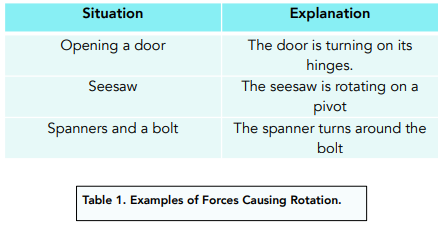
Moments
- The turning effect of a force is called the moment. Moments are used to describe the turning effect of a force. Previously, we mentioned that the turning effect causes the rotation of an object. Now, we can say that moments cause the rotation of an object.
- Moments vary in size. The size of the moment will affect the amount of rotation produced. If a moment is bigger, then the object will experience a lot of rotation. If the moment is small, then the object will experience very little turning force. In the next section, we will discuss how to change the size of a moment.
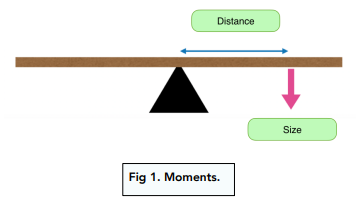
Calculating Moments
This is the equation for calculating the size of a moment:
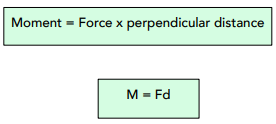
Where:
- moment of a force, M, in newton-metres, Nm
- force, F, in newtons, N
- distance, d, is the perpendicular distance from the pivot to the line of action of the force, in metres, m.
When we are calculating the size of a moment, it is very important to remember that the force is always acting at right angles to the distance measured (Fig 2).
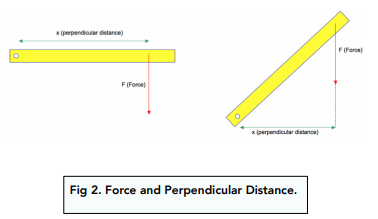
Question: What is the moment of a 4N downwards force acting 0.4m from a pivot?
1. Draw a diagram.
To tackle this question, we should start off by drawing a diagram.

2. Look at the formula.
Now that we have a visual representation, we can see that our force is perpendicular to the distance we were given. Now we can use our formula:
M = Fd
3. Substitute in the numbers.
Once we have put the numbers into the equation, we should get our answer.
M = 4 x 0.4
M = 1.6 Nm
Changing the Size of a Moment
- Moments can be increased. We can increase the size of a moment by either increasing the force applied, or increasing the perpendicular distance from the pivot.
- Moments can be decreased. We can decrease the size of a moment by either decreasing the force applied, or decreasing the perpendicular distance from the pivot.
Balancing Moments
Clockwise and Anticlockwise Moments
Since moments cause objects to rotate, we can classify them by their direction. The two terms that we use to describe the direction of a moment are clockwise and anticlockwise, as in Fig 3.
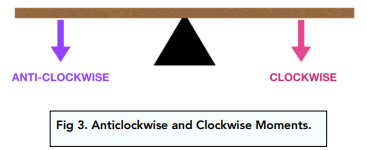
Balancing Moments
In certain situations, moments can balance each other out and the object will stay still (instead of turning). For this to be the case, the total clockwise moment will be equal to the total anticlockwise moment about a pivot.
If the total clockwise moment doesn’t equal the total anti-clockwise moment, the object will rotate:

Calculating Force and Distance from Moments
Previously, we looked at calculating a moment from a force and a distance. Now, we are going to work backwards, using the moment to find the force or distance.
In these situations, we are going to use the fact that the system is balanced. As we mentioned before, in a balanced system, the total clockwise moment will equal the total anticlockwise moment. By using this principle, we are able to form an equation which will help us to solve questions:

Question: Sam and Jess are sat at opposite ends of a seesaw. Jess weighs 300N and is sat 3 metres away from the centre of the pivot. Sam weighs 450N. Whilst they are sat in their current positions, the seesaw is balanced. How far away is Sam sat from the centre of the pivot?
1. We need to draw a diagram.
It is very important that we draw a clear diagram to see exactly what is going on. Add in all the values for the weights and distances that we know. We will simply label the distance we are trying to find as ‘d’.

2. Assign directions to the moments.
In this case, we can see from the diagram that the Sam is creating an anticlockwise moment, whereas Jess is creating a clockwise moment.
3. Calculate the moment that we have information for.
In this question, we can calculate Jess’s moment. We can do this by using the equation
M = Fd
M = 300 x 3
M = 900 Nm
4. Remember that anticlockwise moments = clockwise moments.
The seesaw is balanced, so we know that the anticlockwise moments are equal to the clockwise moments.
5. Substitute numbers into the equation.
We have already calculated Jess’s moment, so we just need to put in the missing information for Sam.
We can use this information to help us create a balanced equation:
anticlockwise moment = clockwise moment
Sam’s moment = Jess’s moment
Fd = Fd (Since M = Fd)
450 x d = 300 x 3
450 x d = 900
d = 900 / 450
d = 2m
Therefore, we can say that Sam is sat 2m away from the centre of the pivot.
Multiple Forces
Question: (continued from previous question)… Sam moves his position on the seesaw, and moves his bag from the ground onto his side of the seesaw. The distance between pivot and Sam is double of the distance between pivot and the bag. The bag weighs 100N and Sam weighs 450 N. Jess has not moved – she is 300N and 3m away from the pivot on the other side. How far is the bag from the pivot? The seesaw is still balanced.
1. We need to draw another diagram.
Draw an updated diagram. The distance from the pivot to the bag can be called d and therefore the distance from the pivot to Sam is 2d.

2. Assign directions to the moments.
In this case, we can see from the diagram that Sam and the bag are creating an anticlockwise moment, whereas Jess is creating a clockwise moment.
3. Calculate the moment that we have information for.
In this question, we can calculate Jess’s moment. We know this is 900 Nm from the previous question.
4. Remember that anticlockwise moments = clockwise moments.
The seesaw is balanced, so we know that the anticlockwise moments are equal to the clockwise moments.
5. Substitute numbers into the equation.
We have already calculated Jess’s moment. We know
anticlockwise moment = clockwise moment
Sam + Bag moment = Jess’s moment = 900
Sam’s moment = 450 x 2d = 900d
Bag’s moment = 100 x d = 100d
Sam + Bag moment = 1000d
1000d = 900
d = 0.9
Therefore, we can say that the bag is 0.9m away from the centre of the pivot, and Sam is 1.8m away.
Objects in Equilibrium
Method
- Gather your equipment. You will need a beam, a ruler, two newton metres, support for the beam and an object to hang from the beam.

FAQs
Balancing moments, also known as torque, refer to the force that causes an object to rotate around a fixed point. In physics, balancing moments are important when considering the stability of an object and whether it will tip over or stay upright.
The factors that affect balancing moments include the position of the object’s center of mass, the length of the lever arm, and the size of the applied force. A longer lever arm or a larger force will produce a greater torque, making it harder for an object to ba
You can balance an object by ensuring that the weight is evenly distributed and the center of mass is positioned over the point of support. This way, the applied forces will produce equal and opposite torques, preventing the object from tipping over.
Force and torque are related in that a force can produce a torque, depending on its position relative to the point around which an object is rotating. The greater the force, the greater the torque it will produce, and vice versa.
Torque can be calculated using the following formula: torque = force x lever arm. The lever arm is the distance from the point of rotation to the point where the force is being applied.
Some real-life examples of balancing moments include a see-saw, a door hinge, and a spinning ice skater. In each of these examples, the forces applied produce torques that must be balanced in order to maintain stability.
The size of an object does not directly affect its balancing moments, but it can affect the position of the object’s center of mass. A larger object may have a more diffuse center of mass, making it more difficult to balance than a smaller, more compact object.
Balancing moments play a crucial role in physics, as they help us understand the stability of objects and how forces can cause them to rotate. Understanding balancing moments is essential for studying fields such as mechanics, engineering, and sports science.





Still got a question? Leave a comment
Leave a comment